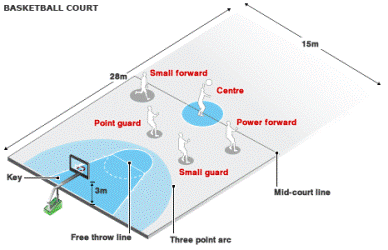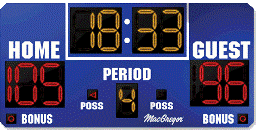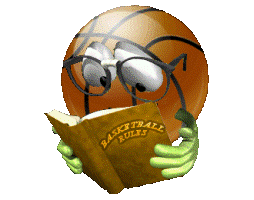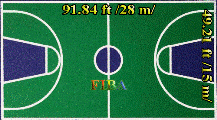Basketball Rules
Basketball is one of the famous team sport, the objective being to shoot a ball through a basket horizontally positioned to score points while following a set of rules. It has evolved many commonly used techniques of shooting, passing, dribbling, and rebounding, as well as specialized player positions and offensive and defensive structures and techniques.Competitive basketball is primarily an indoor sport played on a carefully marked and maintained basketball court, but less regulated variations are often played outdoors in both inner city and remote areas.



Dimensions: the basketball court is a rectangle with:
FIBA
width - 49.21 ft (15 m);
lendht - 91.86 ft (28 m);
Rim height - 10 ft (3.05m);
Restricted arc radius - 4.10 ft (1.25 m);
Center circle diameter - 11.81 ft (3.6 m);
3-point line distance from the basket - 22.15 ft (6.75 m);
Key width - 16.08 ft (4.9 m0;
Free-throw line distance from point on the floor directly below the backboard - 15.09 ft (4.6 m);
Marking lines:
Sidelines - The sidelines are the two boundaries lines running the length of the court. Their location is determined by the width of the court, which is normally 50 feet wide.
Baseline/Endline - The Baseline/Endline runs from sideline to sideline behind the backboard at the ends of the court. They are located four feet behind the basket, and normally have a width of 50 feet. Baseline is used for the offensive end of the court. Endline is used for the back court or defensive end of the court.
Mid Court Line - The mid court line divides the court in half. Offensively, once the ball crosses the Mid Court Line, it becomes a boundary line reducing the offensive playing area to just half of the court. Also, on most levels, the offensive team only has 8 to 10 seconds to advance the ball across the mid court line.




- signal the timer to stop the clock;
- designate the offender to the scorer;
- use his or her fingers to indicate the number of free throws;
- Scorers - Scorers must record, in numerical order, names and numbers of all players; record field goals made and free throws made and missed; keep a running summary of points scored;
- Timers -their responsibility is to keep everyone abreast of key factors while carrying out the timing regulations.



Player Positions:
Center - Centers are generally your tallest players. They generally are positioned near the basket.
Forward - Your next tallest players will most likely be your forwards. While a forward may be called upon to play under the hoop, they may also be required to operate in the wings and corner areas.
- Offensive - The center's goal is to get open for a pass and to shoot. They are also responsible for blocking defenders, known as picking or screening, to open other players up for driving to the basket for a goal. Centers are expected to get some offensive rebounds and put-backs.
- Defensive - On defense, the center's main responsibility is to keep opponents from shooting by blocking shots and passes in the key area. They also are expected to get a lot of rebounds because they're taller.

- Offensive - Forwards are responsible to get free for a pass, take outside shots, drive for goals, and rebound.
- Defensive - Responsibilities include preventing drives to the goal and rebounding.
- Offensive - Dribbling, passing, and setting up offensive plays are a guard's main responsibilities. They also need to be able to drive to the basket and to shoot from the perimeter.
- Defensive - On defense, a guard is responsible for stealing passes, contesting shots, preventing drives to the hoop, and for boxing out.



Scoring
A legal goal is made when a live ball enters the basket from above and remains in or passes through the net.
A successful field goal attempt from the area on or inside the three-point field goal line shall count two points.
A successful field goal attempt from the area outside the three-point field goal line shall count three points.
A field goal accidentally scored in an opponent's basket shall be added to the opponent's score, credited to the opposing player nearest the shooter, and shall be mentioned in a footnote.
A field goal that, in the opinion of the officials, is intentionally scored in the wrong basket shall be disallowed. The ball shall be awarded to the opposing team out-of-bounds at the free throw line extended.
A successful free throw attempt shall count one point.
An unsuccessful free throw attempt which is tapped into the basket shall count two points and shall be credited to the player who tapped the ball in.
If there is a discrepancy in the score and it cannot be resolved, the running score shall be official.

Timing:

End of Period - Each period ends when time expires.
Tie Score-Overtime - If the score is tied at the end of the fourth period, play shall resume in 100 seconds without change of baskets for any of the overtime periods required.
20-Second Timeout - A player's request for a 20-second timeout shall be granted only when the ball is dead or in control of the team making the request.
Tie Score-Overtime - If the score is tied at the end of the fourth period, play shall resume in 100 seconds without change of baskets for any of the overtime periods required.
20-Second Timeout - A player's request for a 20-second timeout shall be granted only when the ball is dead or in control of the team making the request.



Live ball - A live ball is one that is legally in play. The ball becomes live when:
it leaves the referee' s or umpire' s hands on a jump ball
during a throw-in
when the referee or umpire places the ball at a free thrower' s disposal for a free-throw attempt
A ball becomes dead at the sound of the referee or umpire's whistle.
CENTER JUMP - This probably is the only maneuver in basketball that goes back to the game' s invention in December 1891 at Springfield College in Massachusetts. Now, the game (and each overtime period) is started by a jump ball between any two opponents in the center circle.
OTHER "JUMPS" - In situations other than at the start of the game and the start of extra periods, teams will alternate taking the ball out of bounds at the spot nearest to where the situation occurred. The team not obtaining the initial jump will start the alternating process.
JUMP-BALL PROCEDURE - Each jumper must have both feet on or inside the half of the jumping circle that is farther from his or her own basket. The eight nonjumpers must remain entirely outside the circle until the ball has been touched, but they are entitled to alternate positions between opponents around the jumping circle. They may move after the ball has left the official' s hand.
Dead ball - A dead ball is one that isn't legally in play.





- The 24-second clock will start when a team gains new possession of a ball which is in play
- On a throw-in, the 24-second clock shall start when the ball is legally touched on the court by a player;
- If a ball is touched by a defensive player who does not gain possession of the ball, the 24-second clock shall continue to run.
- on all technical fouls or delay of game warnings called on the defensive team, the 24-second clock shall remain the same as when play was stopped, or reset to 10 seconds;
- The 24-second clock is never reset on technical fouls called on the offensive team;
- The 24-second clock shall be reset to 24 seconds:
- Change of possession
- Illegal defense violation
- Personal foul
- Fighting foul
- Kicking the ball or blocking the ball with any part of the leg
- Punching the ball with fist
- Ball contacts the basket ring of the team which is in possession of it



Fouls:
Personal fouls - Personal fouls include any type of illegal physical contact:
Personal foul penalties - If a player is shooting while a being fouled, then he gets free throw - two, if his shot doesn't go in; one,if his shot does go in;
Charging - An offensive foul that is committed when a player pushes or runs over a defensive player.
Blocking - Blocking is illegal personal contact resulting from a defender not establishing position in time to prevent an opponent's drive to the basket.
Flagrant foul - Violent contact with an opponent - hitting, kicking, and punching.
Intentional foul - When a player makes physical contact with another player with no reasonable effort to steal the ball. It is a judgment call for the officials.
Technical foul - A player or a coach can commit this type of foul. Foul language, obscenity, obscene gestures, and even arguing can be considered a technical foul, as can technical details regarding filling in the scorebook improperly or dunking during warm-ups.


- Hitting
- Pushing
- Slapping
- Holding
- Illegal pick/screen - when an offensive player is moving (makes physical contact with a defender in an attempt to block the path of the defender)
- Three free throws are awarded if the player is fouled while shooting for a three-point goal and they miss their shot. If a player is fouled while shooting a three-point shot and makes it anyway, he is awarded one free throw. Thus, he could score four points on the play.
- Inbounds. If fouled while not shooting, the ball is given to the team the foul was committed upon. They get the ball at the nearest side or baseline, out of bounds, and have 5 seconds to pass the ball onto the court.
- One & one. If the team committing the foul has seven or more fouls in the game, then the player who was fouled is awarded one free throw. If he makes his first shot, then he is awarded another free throw.
- Ten or more fouls. If the team committing the foul has ten or more fouls, then the fouled player receives two free throws.
Free Throw Situations - Free throws are awarded for on the various fouls and account for approximately 1/4 of the points scored in a game. The different free throw:
Two (or Three) Free Throws - are awarded when a player is fouled in the act of shooting and the shot is unsuccessful
And-One – when fouled in the act of shooting and the shot is successful, the basket counts and one free throw is awarded.
Bonus (One and One) – free throws are awarded on non-shooting fouls once the maximum number of team fouls for a period is exceeded. If the bonus situation, if the first free throw is made a second free throw is award. If the first free throw is missed, ball is in play.
Double Bonus – once a team reaches 10 team fouls in a half, two free throws are awarded.
Technical Fouls – two free throws are awarded on technical fouls. The opposing team has option of naming the player to shoot the free throw attempts.
Double fouls – when players on opposite teams commit personal fouls simultaneously. The personal fouls are recorded but no free throws are awarded.
False Double Foul – when multiple fouls occur in tandem, the fouls are administered in the order in which they occur.


Vionaltions:
Walking/Traveling - Taking more than 'a step and a half' without dribbling the ball is traveling.
Carrying/palming - When a player dribbles the ball with his hand too far to the side of.
Double Dribble - Dribbling the ball with both hands on the ball at the same time or picking up the dribble and then dribbling again.
Held ball - Occasionally, two or more opposing players will gain possession of the ball at the same time. In order to avoid a prolonged and/or violent tussle, the referee stops the action and awards the ball to one team or the other on a rotating basis.
Goaltending - If a defensive player interferes with a shot while it's on the way down toward the basket, while it's on the way up toward the basket after having touched the backboard, or while it's in the cylinder above the rim, it's goaltending and the shot counts. If committed by an offensive player, it's a violation and the ball is awarded to the opposing team for a throw-in.
Backcourt violation - Once the offense has brought the ball across the mid-court line, they cannot go back across the line during possession.
Time restrictions - A player passing the ball inbounds has five seconds to pass the ball. If he does not, then the ball is awarded to the other team.








